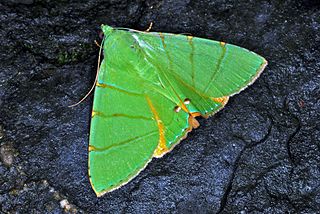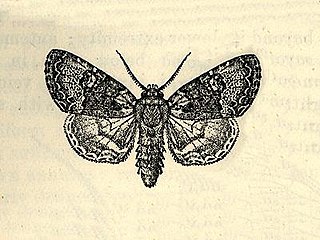
The Calpinae are a subfamily of moths in the family Erebidae described by Jean Baptiste Boisduval in 1840. This subfamily includes many species of moths that have a pointed and barbed proboscis adapted to piercing the skins of fruit to feed on juice, and in the case of the several Calyptra species of vampire moths, to piercing the skins of mammals to feed on blood. The subfamily contains some large moths with wingspans longer than 5 cm (2 in).

Eulepidotis is a genus of moths of the family Erebidae erected by Jacob Hübner in 1823.

Cropia indigna is a moth of the family Noctuidae first described by Francis Walker in 1858. It is found on Cuba, Hispaniola and Jamaica.

Cropia subapicalis is a moth of the family Noctuidae first described by Francis Walker in 1858. It is found on Hispaniola and Jamaica.

Eulepidotis ilyrias is a moth of the family Erebidae first described by Pieter Cramer in 1776. It is found in French Guiana.
Eulepidotis addens is a moth of the family Erebidae first described by Francis Walker in 1858. It is found in Saint Kitts, Montserrat, Dominica, Saint Lucia, Saint Vincent, Jamaica, Hispaniola, Puerto Rico, Mexico, Guatemala, Venezuela and Brazil. It was reported from Texas by Ed Knudson and Charles Bordelon in 2004.

Eulepidotis alabastraria is a moth of the family Erebidae first described by Jacob Hübner in 1823. Many former members of the moth family Noctuidae are classified in the family Erebidae now, along with all of the former members of the families Arctiidae and Lymantriidae. This re-classification has not yet met with general consensus, and many resources and publications still follow the older classification scheme. It is found from the southern part of the United States to Central and South America.
Eulepidotis albidus is a moth of the family Erebidae first described by Émile Blanchard in 1852. It is found in the Neotropical realm, including Chile.
Eulepidotis caeruleilinea is a moth of the family Erebidae first described by Francis Walker in 1858. It is found in the Neotropical realm, including French Guiana, Costa Rica and the Brazilian states of Amazonas and Rio de Janeiro.

Eulepidotis dominicata is a moth of the family Erebidae first described by Achille Guenée in 1852. It is found in the Neotropics, including Costa Rica, Brazil, Peru, Guyana and Ecuador. Reports from Texas and Florida are unconfirmed.
Eulepidotis detracta is a moth of the family Erebidae first described by Francis Walker in 1858. It is found in the Neotropics, including Brazil.

Eulepidotis electa is a moth of the family Erebidae first described by Harrison Gray Dyar Jr. in 1914. It is found in the Neotropics, including Costa Rica and Panama. It has recently been recorded from the US state of Arizona.
Eulepidotis hebe is a moth of the family Erebidae first described by Heinrich Benno Möschler in 1890. It is found in the Neotropics, including Puerto Rico.

Eulepidotis juncida is a moth of the family Erebidae first described by Achille Guenée in 1852. It is found in the Neotropics, including Mexico, Honduras, Costa Rica, Peru, French Guiana, Venezuela, Bolivia and Colombia.
Eulepidotis merricki is a moth of the family Erebidae first described by William Jacob Holland in 1902. It is found in Jamaica, Cuba, and Puerto Rico. The species was originally described from the US state of Pennsylvania, but the specimen was probably imported with tropical fruit. The species is not present in the Nearctic.
Eulepidotis reducens is a moth of the family Erebidae first described by Harrison Gray Dyar Jr. in 1914. It is found in the Neotropics, including Venezuela.
Eulepidotis santarema is a moth of the family Erebidae first described by Francis Walker in 1865. It is found in the Neotropics, including the Brazilian state of Amazonas and Guyana.
Eulepidotis scita is a moth of the family Erebidae first described by Francis Walker in 1869. It is found in the Neotropics.
Eulepidotis testaceiceps is a moth of the family Erebidae first described by Felder and Rogenhofer in 1874. It is found in the Neotropics, including Costa Rica, French Guiana and Guyana.








